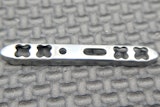Manufacturers have heard about how Internet of Things movement can generate, store and analyze data points, but the future of IoT is even more exciting.
Sean Riley, the Global Manufacturing & Supply Chain Solutions Director at Software AG, recently released his list of supply chain and manufacturing predictions for 2015. Riley’s list includes predictions about automation, re-shoring, 3D printing and, you guessed it, the Internet of Things.
I touched base with Sean Riley to chat about how the Internet of Things will shape the manufacturing industry in the coming year.
Bridget Bergin (BB): How is the Internet of Things changing the way manufacturers manage their supply chains?
Sean Riley (SR): It is giving manufacturers a granular level of visibility, which allows for specific exactness that was previously untenable. For example, if you have a product arriving on a container ship and you are shipping that product to its final destination on a truck, both the arrival of the ship and the arrival of the truck can be matched exactly to reduce wait times and cost for both assets. This synchronization ability does other great things, such as reduce product risk from theft or handling quality.
BB: What would you say to a manufacturer concerned with the security risks of implementing IoT technology?
SR: Security should never be taken lightly, especially with all of the recent cyberattacks we have seen. A manufacturer who wants to make sure that he or she has done the best job to mitigate the risk will want to talk to the analysts and see who are in the leader quadrants for security software implementation and data transmission and analysis. The companies in data transmission and analysis have specific security thresholds built into their tools to ensure that security is as up-to-date as possible.
BB: One of your 10 predictions is the increased adoption of automation. Should manufacturers be concerned about potential job loss or excited about lower costs?
SR: This is always a sensitive topic for me because my grandparents came over to the U.S. right before the Great Depression, and they spent 38 and 44 years on production lines for automotive companies.
I think manufacturers should be really excited about the lower costs and very cognizant of the potential job change. I use the term “job change” because there are human assets that can be reused—just not in the form they are in right now. As manufacturing right-shores and returns to the U.S., it will provide very significant benefits specifically in responsiveness and lead-time going back to the supply chain.
BB: What are some challenges manufacturers face in implementing IoT? What are some of the benefits?
SR: Security is probably the largest challenge, but another big challenge is managing and understanding the scale and the speed of the data growth and transmission. Once a manufacturer has implemented an IoT program, it is important to make sure there is a pipeline and an analytic engine for the data that can manage more capacity. There is a difference between the number of events per second you estimate and the actual number to which that will scale. When you want to analyze the IoT data, you need to be sure that you the ability to handle several times more data than you originally thought you might have.
Key benefits are unparalleled visibility and responsiveness. You are going to be able to act extraordinarily quickly in a sub-second level to be able to identify challenges. This results in decreased costs from an action perspective, because you have more options and lower-cost options the earlier you act. You’ll be able to deliver to your customers exactly what they want, when they want it and in the form they want it because you are able to connect their usage data, your production and supply chain data into one system and see what is happening at any time. From that complete visibility of an entire value chain to the end consumer, you are able to cull out just the exceptions from a massive pile of data and deal with them fluidly and easily.
BB: The Information Technology and Innovation Foundation has recently released a report entitled, “The Myth of America’s Manufacturing Renaissance: The Real State of U.S. Manufacturing.” Your top ten supply chain and manufacturing predictions for 2015 are extremely optimistic, however. Would you say there is a manufacturing revolution happening in America? If so, what role does IoT play?
SR: In some industries, there is going to be a manufacturing renaissance. It will be eye-opening because production will re-shore and the traditional jobs associated with manufacturing will not be coming back. Plants will be fundamentally different than they were when the jobs left. This will occur in several discrete industries. Other industries will still move production offshore at about the same pace. Depending on the industry, your production will either move overseas or be brought back. The end result will be a slight net gain overall from a re-shoring perspective, but it will not be a giant resurgence in the near term.
IoT is allowing for the right-shoring trend, because it allows for connections to be made in a very cost-effective manner. IoT is the fundamental enabler that makes it possible for companies to bring production back, because they can connect every sensor and piece of equipment to the network at a low cost. All you need is a network with enough capacity to keep embedding IoT sensors and analyzing the data, and you are ready to go.
ENTRIES OPEN: Establish your company as a technology leader. For 50 years, the R&D 100 Awards, widely recognized as the “Oscars of Invention,” have showcased products of technological significance. Learn more.























